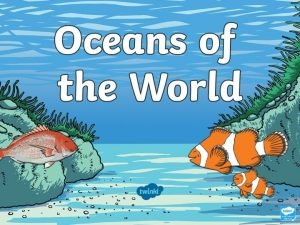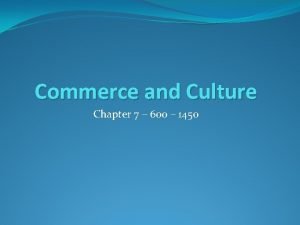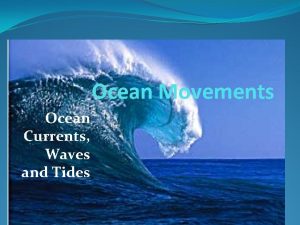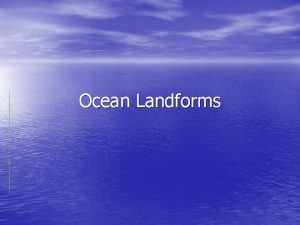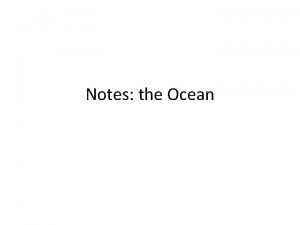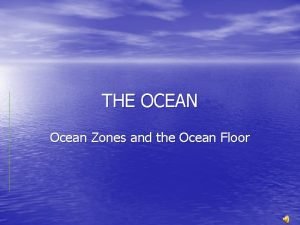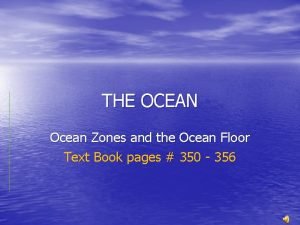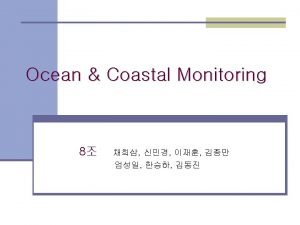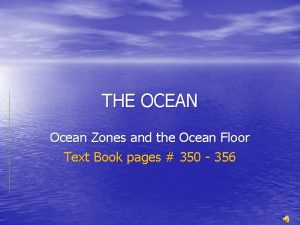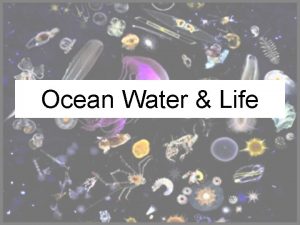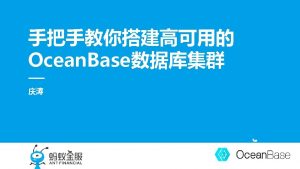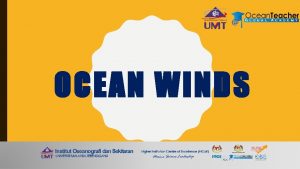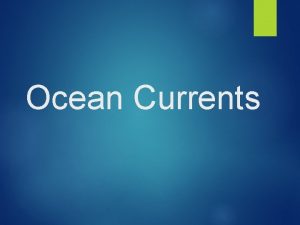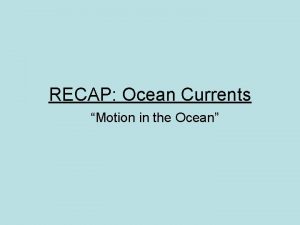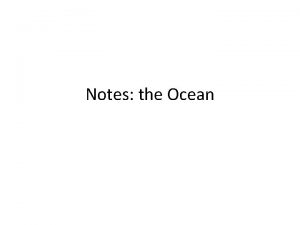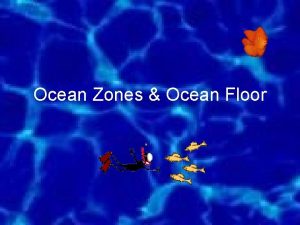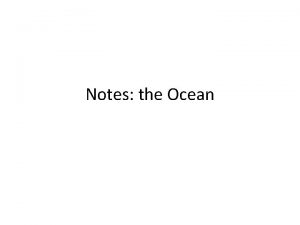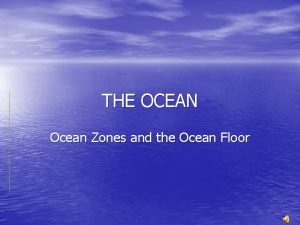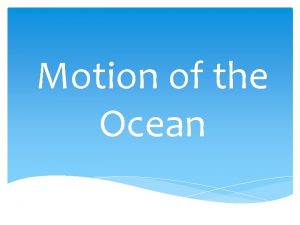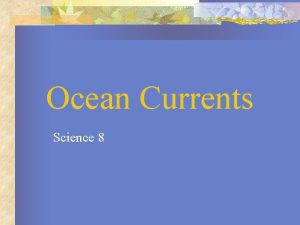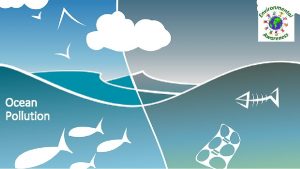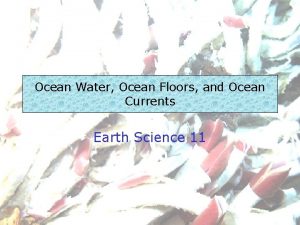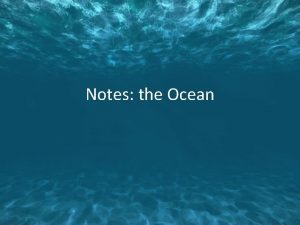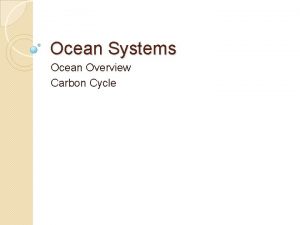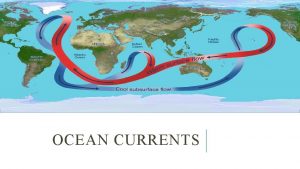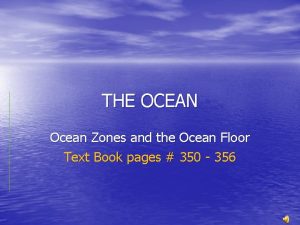Lecture 1 a THE OCEAN WORLD Chapter 1




























- Slides: 28

Lecture 1 a: THE OCEAN WORLD Chapter 1

OCEAN FACTS • From Greek word Okeanos = outer sea • Body of salty water that occupies Earth’s depressions (below sea level) • 71% of Earth’s surface covered by ocean • 97% of the Earth’s total water • Covers 361 million square kilometers of Earth’s surface • Weighs 141 billion metric tons

OCEAN FACTS • Av. depth = 3. 8 km, average land elevation = 840 m • Depth tiny compared to distance to center of the earth • Av. temperature = 3. 9°C (39°F) • Av. salinity = 35 ppt (3. 5%) • 0. 02% of Earth’s mass • Most large cities on coast – 50% of humans live within 150 miles of the coastline

Fig. 1. 1

Fig. 1. 2

THE 5 OCEANS Can be referred to as the world ocean

PACIFIC OCEAN • Largest ocean covering 30% of Earth’s surface • Av. depth 4. 3 km • Deepest part = Mariana Trench 10. 9 km • Volcanically very active www. eoearth. org

ATLANTIC OCEAN • 2 nd largest ocean • Covers 20% of Earth’s surface • S-shaped basin • Av. depth 3. 3 km • Second youngest ocean – 130 million years old • Getting larger! www. eoearth. org

INDIAN OCEAN • 3 rd largest ocean • Covers 14% of Earth’s surface • Av. depth 3. 9 km • Lies in tropics – warmest surface temperatures and very salty (32 -37 ppt) • Landlocked and open to Southern Ocean www. eoearth. org

SOUTHERN OCEAN • Below 60°S • 4% of Earth’s surface • 4 -5 km deep • Very strong ocean currents • Dangerous to navigate www. eoearth. org

ARCTIC OCEAN • Smallest ocean • Covers 3% of Earth’s surface • Av. depth 1 km (shallowest) • Nearly landlocked • Covered in ice www. eoearth. org

OCEAN VERSUS SEA • Seas are smaller and shallower • Saltwater composition • Enclosed by land • Connected to the ocean • e. g. Mediterranean, Caribbean

WHAT IS OCEANOGRAPHY? • The study of the ocean/marine environment • Marine Science

MARINE GEOLOGISTS/GEOLOGICAL OCEANOGRAPHERS • Composition of Earth • Seafloor sediments • Plate movement esp. earthquake prediction

PHYSICAL OCEANOGRAPHERS • Waves and currents • Ocean-atmosphere interactions • Predict long term climate change

MARINE BIOLOGISTS/BIOLOGICAL OCEANOGRAPHERS • Distribution and behavior of marine organisms • Pollution impacts • Fisheries

CHEMICAL OCEANOGRAPHERS • Dissolved solids and gases • Relationship to geology and biology • Aid in climate change predictions

OTHER RESEARCH AREAS Astronomy: - tidal forces - origin of life Geography: - weather and climate Engineering: - design and construction of structures used in or on ocean - oil platforms, harbors, shipyards Archaeology: - interactions between humans and the sea - shipwrecks, earthquake disasters

THE SCIENTIFIC METHOD Need to prove or disprove

Fig. 1. 5

OCEAN EXPLORATION • Early civilizations voyaged for trade and exploration • Egyptians: – Library at Alexandria (founded 3 rd century B. C. ) stored information on explorations – Principle of celestial navigation – Circumference of the Earth, and system of longitude and latitude • Polynesia colonized thousands of years ago from Southeast Asia • China (1400’s) explored Indian and Atlantic Oceans

EUROPEAN EXPLORERS • Henry the Navigator – explored west coast of Africa • Christopher Columbus – never saw North American mainland, but his stories caused other explorers to follow • Ferdinand Magellan – died en route but remaining crew circumnavigated the globe

Fig. 1. 17 First voyage around the world, only 18 of the 260 sailors survived, took 3 years

VOYAGES AND SCIENCE James Cook (UK), British Royal Navy • HMS Endeavour (1768) – assert British presence in South Seas, greatly contributed to scientific oceanography – Verification of calculations of planetary orbits – Charting of New Zealand the Great Barrier Reef, Tonga and Easter Islands – Initiation of friendly relations with many native populations – Sampling marine life, land plants and animals – Recording data concerning the ocean floor and geological formations

• The United States Exploring Expedition launched in 1838 was a naval and scientific expedition. • The HMS Beagle, on which Charles Darwin served as a naturalist, voyaged to South America and some Pacific Islands. • (BELOW) HMS Challenger expedition of 1872 -1876 was the first oceanic expedition dedicated to scientific research. Fig. 1. 26

HMS CHALLENGER • 4 year voyage: – Life exists below 549 m (Azoic hypothesis), sampled down to 8000 m! – Discovered 4717 new species – Numerous salinity, temperature and density measurements – physical description of ocean – Ocean currents – Distribution of sediments – Location of coral reefs

OCEAN EXPLORATION IN THE 20 th CENTURY • Polar exploration – reached both the North and South Poles • Atlantis – confirmed presence of Mid-Atlantic Ridge • Trieste – a blimp-like bathyscaphe which descended into the Mariana Trench • Glomar Challenger - drilling ship, samples collected confirmed evidence for seafloor spreading

Echo sounders Deep sea drilling Submersible
 Chapter 15 ocean water and ocean life
Chapter 15 ocean water and ocean life 01:640:244 lecture notes - lecture 15: plat, idah, farad
01:640:244 lecture notes - lecture 15: plat, idah, farad Divergent convergent transform
Divergent convergent transform Ocean ocean convergent boundary
Ocean ocean convergent boundary Ocean to ocean convergent boundary
Ocean to ocean convergent boundary Ocean ocean convergent boundary
Ocean ocean convergent boundary Sciencechannel.com/activate
Sciencechannel.com/activate Convergent oceanic oceanic plate boundary
Convergent oceanic oceanic plate boundary Red ocean vs blue ocean
Red ocean vs blue ocean Smallest ocean in the world
Smallest ocean in the world Weaving the web of an indian ocean world
Weaving the web of an indian ocean world Ap world history chapter 25 africa and the atlantic world
Ap world history chapter 25 africa and the atlantic world Hát kết hợp bộ gõ cơ thể
Hát kết hợp bộ gõ cơ thể Bổ thể
Bổ thể Tỉ lệ cơ thể trẻ em
Tỉ lệ cơ thể trẻ em Chó sói
Chó sói Tư thế worms-breton
Tư thế worms-breton Hát lên người ơi alleluia
Hát lên người ơi alleluia Môn thể thao bắt đầu bằng từ đua
Môn thể thao bắt đầu bằng từ đua Thế nào là hệ số cao nhất
Thế nào là hệ số cao nhất Các châu lục và đại dương trên thế giới
Các châu lục và đại dương trên thế giới Công thức tính độ biến thiên đông lượng
Công thức tính độ biến thiên đông lượng Trời xanh đây là của chúng ta thể thơ
Trời xanh đây là của chúng ta thể thơ Mật thư tọa độ 5x5
Mật thư tọa độ 5x5 Phép trừ bù
Phép trừ bù độ dài liên kết
độ dài liên kết Các châu lục và đại dương trên thế giới
Các châu lục và đại dương trên thế giới Thể thơ truyền thống
Thể thơ truyền thống









